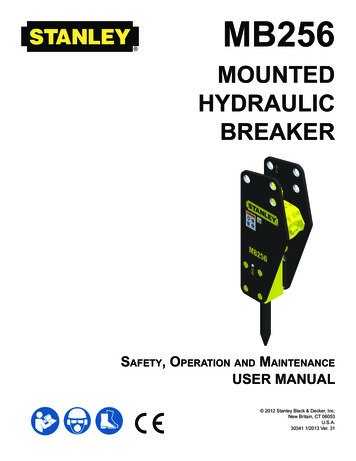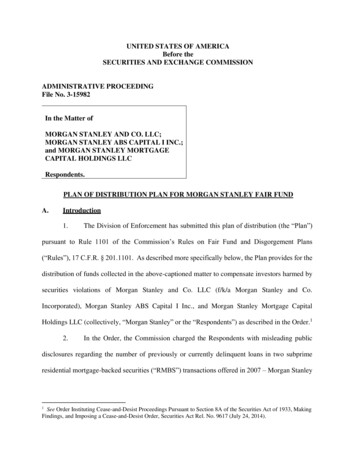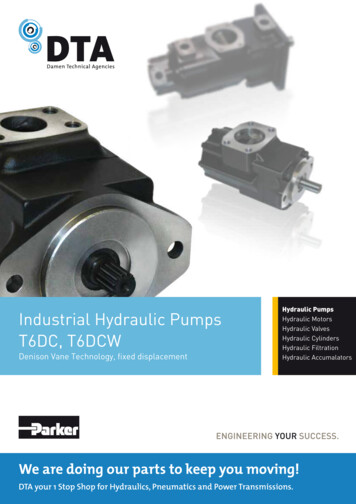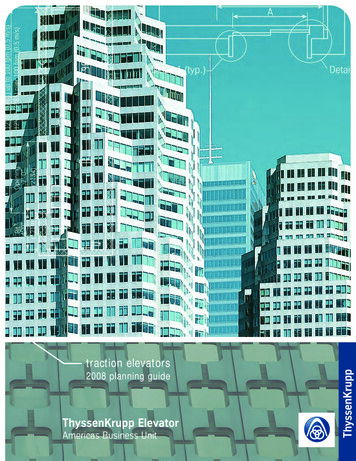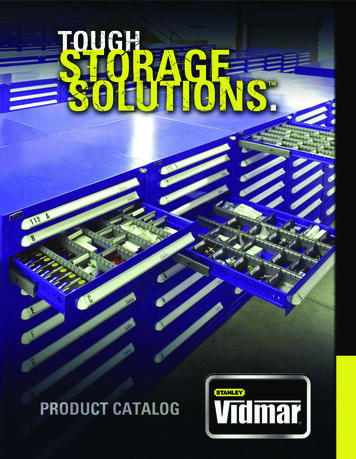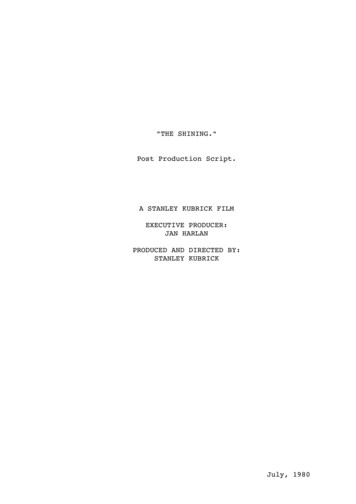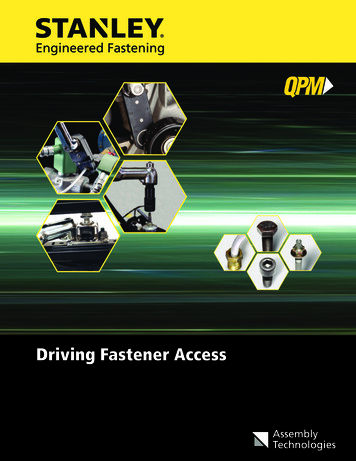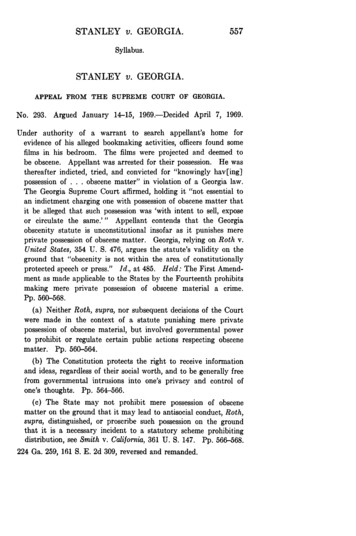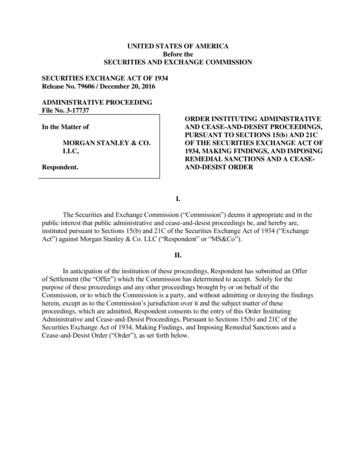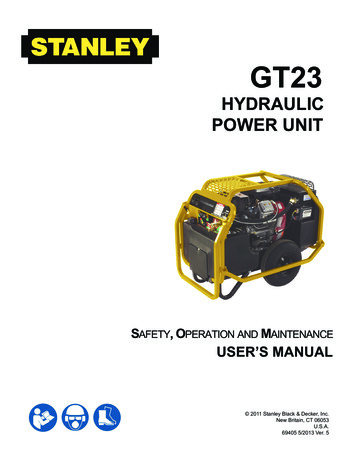
Transcription
GT23HYDRAULICPOWER UNITSAFETY, OPERATION AND MAINTENANCEUSER’S MANUAL 2011 Stanley Black & Decker, Inc.New Britain, CT 06053U.S.A.69405 5/2013 Ver. 51
NOTES2
TABLE OF CONTENTSSAFETY SYMBOLS. 4SAFETY PRECAUTIONS. 5TOOL STICKERS & TAGS. 6HYDRAULIC HOSE REQUIREMENTS. 7HOSE SAFETY TAGS. 7HOSE RECOMMENDATIONS. 8HTMA REQUIREMENTS. 9OPERATION. 10PREPARATION FOR USE. 10CONTROLS. 12STARTUP. 12FOR 8 GPM OPERATION. 12FOR 12 GPM OPERATION. 12COLD WEATHER STARTUP. 13SHUTDOWN. 13ROUTINE MAINTENANCE. 14STORAGE. 14PROGRAMMABLE CONTROLLER. 15TROUBLESHOOTING GUIDELINES. 15FAULT CODES. 16TESTING & TROUBLESHOOTING. 17TESTING THE HYDRAULIC CIRCUIT. 17TESTING THE 8 GPM HTMA TYPE II CIRCUIT. 17OR THE 12 GPM TYPE III CIRCUIT. 17TROUBLESHOOTING. 18SPECIFICATIONS. 19BRIGGS ENGINE ASSEMBLY. 20BRIGGS ENGINE PARTS LIST. 21FUEL TANK & CAP. 22FRAME PARTS. 23HOSES, FITTINGS & CLAMPS. 24MAIN POWER UNIT WIRING HARNESS. 25IMPORTANTTo fill out a Product Warranty Recording form, and for information on your warranty,visit Stanleyhydraulic.com and select the Warranty tab.(NOTE: The warranty recording form must be submitted to validate the warranty).SERVICING: This manual contains safety, operation, and routine maintenance instructions. Stanleyrecommends that servicing of hydraulic tools, other than routine maintenance, must be performed by anauthorized and certified dealer. Please read the following warning.WARNINGSERIOUS INJURY OR DEATH COULD RESULT FROM THE IMPROPER REPAIR OR SERVICE OF THIS TOOL.REPAIRS AND / OR SERVICE TO THIS TOOL MUST ONLY BEDONE BY AN AUTHORIZED AND CERTIFIED DEALER.For the nearest authorized and certified dealer, call Stanley Hydraulic Tools at the number listed on theback of this manual and ask for a Customer Service Representative.3
SAFETY SYMBOLSSafety symbols and signal words, as shown below, are used to emphasize all operator, maintenance and repair actions which, if not strictly followed, could result in a life-threatening situation, bodily injury or damage to equipment.This is the safety alert symbol. It is used to alert you to potential personal injuryhazards. Obey all safety messages that follow this symbol to avoid possibleinjury or death.DANGERThis safety alert and signal word indicate an imminently hazardous situationwhich, if not avoided, will result in death or serious injury.WARNINGThis safety alert and signal word indicate a potentially hazardous situationwhich, if not avoided, could result in death or serious injury.CAUTIONThis safety alert and signal word indicate a potentially hazardous situationwhich, if not avoided, could result in death or serious injury.CAUTIONThis signal word indicates a potentially hazardous situation which, if not avoided, may result in property damage.NOTICEThis signal word indicates a situation which, if not avoided, will result in damageto the equipment.IMPORTANTThis signal word indicates a situation which, if not avoided, may result in damage to the equipment.Always observe safety symbols. They are included for your safety and for the protection of the tool.LOCAL SAFETY REGULATIONSEnter any local safety regulations here. Keep these instructions in an area accessible to the operator and maintenance personnel.4
SAFETY PRECAUTIONSTool operators and maintenance personnel must always comply with the safety precautions given in this manual and on thestickers and tags attached to the equipment.These safety precautions are given for your safety. Review them carefully before operating the tool and before performinggeneral maintenance or repairs.Supervising personnel should develop additional precautions relating to the specific work area and local safety regulations. Ifso, place the added precautions in the space provided on page 4.In addition to this manual, read and understand safety and operating instructions in the Engine Operation Manual furnishedwith the power unit.The Hydraulic Power Unit will provide safe and dependable service if operated in accordance with the instructions given in thismanual. Read and understand this manual and any stickers and tags attached to the Power Unit. Failure to do so could resultin personal injury or equipment damage. Operator must start in a work area without bystanders. The operator must be familiar with all prohibited work areas such asexcessive slopes and dangerous terrain conditions. Establish a training program for all operators to ensure safe operation. Do not operate the power unit unless thoroughly trained or under the supervision of an instructor. Always wear safety equipment such as goggles, ear, head protection, and safety shoes at all times when operating thepower unit and a hydraulic tool. Do not inspect or clean the power unit while it is running. Accidental engagement of the unit can cause serious injury. Always use hoses and fittings rated at 2500 psi/172 bar with a 4 to 1 safety factor. Be sure all hose connections are tight. Be sure all hoses are connected for correct flow direction to and from the tool being used. Do not inspect hoses and fittings for leaks by using bare hands. “Pin-hole” leaks can penetrate the skin. NEVER OPERATE THE POWER UNIT IN A CLOSED SPACE. Inhalation of engine exhaust can be fatal. Do not operate a damaged, improperly adjusted power unit. Never wear loose clothing that can get entangled in the working parts of the power unit. Keep all parts of your body away from the working parts of the power unit. Keep clear of hot engine exhaust. Do not add fuel to the power unit while the power unit is running or is still hot. Do not operate the power unit if gasoline odor is present. Do not use flammable solvents around the power unit engine. Do not operate the power unit within 3.3 ft/1 m of buildings, obstructions or flammable objects. Do not reverse tool rotation direction by changing fluid flow direction. Allow power unit engine to cool before storing in an enclosed space. Always keep critical tool markings, such as labels and warning stickers legible. To avoid personal injury or equipment damage, all tool repair, maintenance and service must only be performed by authorized and properly trained personnel.5
TOOL DECALSStanley Dash Sticker 62302Single Circuit Sticker 685956
HYDRAULIC HOSE REQUIREMENTSHOSE TYPESThe rated working pressure of the hydraulic hose must be equal to or higher than the relief valve setting on thehydraulic system.There are three types of hydraulic hose that meet this requirement and are authorized for usewith Stanley Hydraulic Tools. They are:Certified non-conductive - constructed of thermoplastic or synthetic rubber inner tube, synthetic fiberbraid reinforcement, and weather resistant thermoplastic or synthetic rubber cover. Hose labeled certified nonconductive is the only hose authorized for use near electrical conductors.Wire-braided (conductive) - constructed of synthetic rubber inner tube, single or double wire braid reinforcement, and weather resistant synthetic rubber cover. This hose is conductive and must never be used nearelectrical conductors.Fabric-braided (not certified or labeled non-conductive) - constucted of thermoplastic or synthetic rubberinner tube, synthetic fiber braid reinforcement, and weather resistant thermoplastic or synthetic rubber cover. Thishose is not certified non-conductive and must never be used near electrical conductors.HOSE SAFETY TAGSTo help ensure your safety, the following DANGER tags are attached to all hose purchased from Stanley Hydraulic Tools. DO NOT REMOVE THESE TAGS.If the information on a tag is illegible because of wear or damage, replace the tag immediately. A new tag may beobtained from your Stanley Distributor.D A N G E RD A N G E R3. DO NOT EXCEED HOSE WORKING PRESSURE OR ABUSE HOSE. IMPROPER USE ORHANDLING OF HOSE COULD RESULT IN BURST OR OTHER HOSE FAILURE. KEEPHOSE AS FAR AWAY AS POSSIBLE FROM BODY AND DO NOT PERMIT DIRECT CONTACTDURING USE. CONTACT AT THE BURST CAN CAUSE BODILY INJECTION AND SEVEREPERSONAL INJURY.1 FAILURE TO USE HYDRAULIC HOSE LABELED AND CERTIFIED AS NON-CONDUCTIVEWHEN USING HYDRAULIC TOOLS ON OR NEAR ELECTRIC LINES MAYRESULT IN DEATHOR SERIOUS INJURY.FOR PROPER AND SAFE OPERATION MAKE SURE THAT YOU HAVE BEEN PROPERLYTRAINED IN CORRECT PROCEDURES REQUIRED FOR WORK ON OR AROUNDELECTRIC LINES.4. HANDLE AND ROUTE HOSE CAREFULLY TO AVOID KINKING, ABRASION, CUTTING, ORCONTACT WITH HIGH TEMPERATURE SURFACES. DO NOT USE IF KINKED. DO NOT USEHOSE TO PULL OR LIFT TOOLS, POWER UNITS, ETC.2. BEFORE USING HYDRAULIC HOSE LABELED AND CERTIFIED AS NON-CONDUCTIVE ONOR NEAR ELECTRIC LINES. WIPE THE ENTIRE LENGTH OF THE HOSE AND FITTINGWITH A CLEAN DRY ABSORBENT CLOTH TO REMOVE DIRT AND MOSISTURE AND TESTHOSE FOR MAXIMUM ALLOWABLE CURRENT LEAKAGE IN ACCORDANCE WITH SAFETYDEPARTMENT INSTRUCTIONS.5. CHECK ENTIRE HOSE FOR CUTS CRACKS LEAKS ABRASIONS, BULGES, OR DAMAGE TOCOUPLINGS IF ANY OF THESE CONDITIONS EXIST, REPLACE THE HOSE IMMEDIATELY.NEVER USE TAPE OR ANY DEVICE TO ATTEMPT TO MEND THE HOS
This is the safety alert symbol. It is used to alert you to potential personal injury hazards. Obey all safety messages that follow this symbol to avoid possible injury or death. DANGER This safety alert and signal word indicate an imminently hazardous situation which, if not avoided, will result in death or serious injury. WARNING This safety alert and signal word indicate a potentially .
